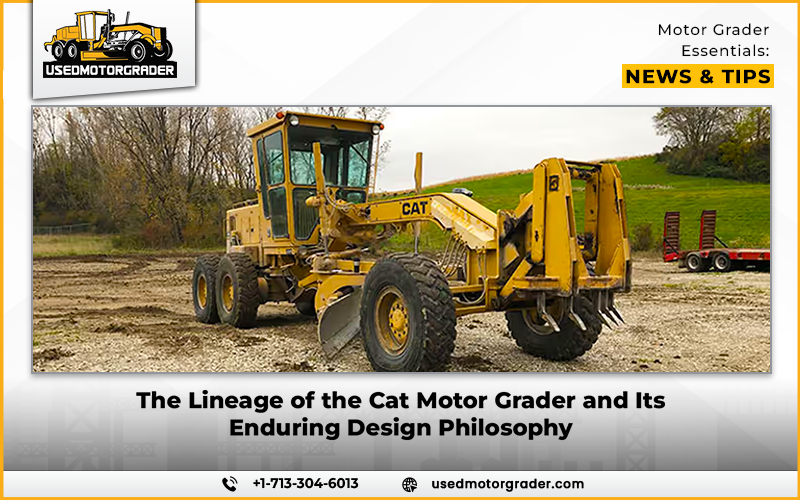In the world of construction and roadwork, few machines carry as much history and continuity as the Cat motor grader. This philosophy of balancing power, precision, and operator-centric engineering, which has been in place since the introduction of the company in the 1930s, still influences the design of current models. Although engineers have made modern graders more technologically advanced and their ergonomics more sophisticated, they still base their mechanical principles on a blueprint that is almost a century old.
A Legacy Born in the 1930s
During the first half of the 20th century, rapid infrastructure developments, including highways and airstrips, prompted Caterpillar to produce a versatile motor grader. The engineers of the company realized that there must be a machine that would provide both the brute force to shape the surfaces and the fine control to provide precise grades.
Two of these innovations were immediately noticeable: the tandem drive system to enhance traction and stability, and the blade mechanism that was flexible to adjust. These aspects made the Cat motor grader unique, and the standard of operation would be emulated by others decades later.
A Philosophy that Withstood the Test of Time
Design is not about reinvention all the time at Caterpillar. It is about refinement. Throughout the decades, the company concentrated on the optimization of the ratio between mechanical reliability and convenience of use.
The most important priorities have been the same:
- Operator efficiency: The machines are made to minimize fatigue and enhance accuracy.
- Reliability: Parts are designed to endure extreme environments.
- Versatility: Graders can work on a variety of jobs, including road maintenance and large earthmoving.
This strategy has made Caterpillar machines remain in demand despite the evolving industry demands and technological times.
From Levers to Electro-Hydraulics: The Evolution of Core Features
Although the core of the Cat motor grader is still recognizable, its separate parts have changed dramatically throughout the decades.
- Tandem Drive System: This was initially mechanical, but it has undergone advanced engineering to support more work and to stay stable on rough surfaces.
- Blade Controls: Mechanical levers were replaced by electro-hydraulic controls, which provided smoother and more accurate blade movements with reduced effort by the operator.
- Visibility and Ergonomics: Open-air designs of the early days have given way to enclosed and climate-controlled cabs with clear visibility and comfortable working conditions in all weather conditions.
- Frame & Chassis: Metallurgy and structural engineering improvements have made graders stronger without compromising maneuverability.
All the changes enhanced performance without removing the familiar feel that experienced operators have relied on over generations.
Modern Technology with a Classic Backbone
Despite the incorporation of the latest technology, Caterpillar has made sure that the graders of today are true to their mechanical roots.
GPS and Automated Grade Control: Modern graders can work to the millimeter, minimizing rework and material waste.
Telematics: Real-time performance data and maintenance alerts ensure the efficient operation of machines.
Better Materials: The use of lighter but stronger alloys makes them stronger and more durable, and fuel-efficient.
In both instances, the upgrades are additions to, not replacements of, the time-tested basics of grader design.
Performance in the Field: Then and Now
During the 1930s, the success of a motor grader was gauged in terms of durability and mechanical reliability. Speed, precision, and operating costs are also performance metrics today. However, during both periods, Caterpillar graders have been relied upon to perform in tough conditions. Whether it is repairing rural roads or working on large-scale construction projects in the city.
Contractors continue to commend the machine for its ability to perform different workloads without compromising accuracy. This is a mark of its classic design.
Why the Design Still Works Today
The timelessness of the Cat motor grader can be explained by some eternal engineering facts:
- Precision grading requires stability and control as a non-negotiable.
- The productivity is directly related to operator comfort.
- Mechanical reliability minimizes downtime and lifecycle expenses.
Adhering to these ideals has allowed Caterpillar to create machines that are both comfortable for an experienced operator and have the latest technology to meet the needs of the modern world.
The Next Chapter in the Lineage
The Cat motor grader of the future will probably have AI-aided controls, more automation, and possibly fully electric motors. Trainers might use augmented reality to train operators, and machines might use machine-to-machine communication to allow completely integrated jobsite processes.
However, despite these innovations. It is probable that the fundamental design will still be there. Grounded on the same philosophy that made the original models successful almost a hundred years ago.
Lastly
The Cat motor grader is not only a machine, but a living proof that good design principles can be timeless. Caterpillar has managed to combine its mechanical heritage with innovation to produce a machine that bridges the gap between the past and the present in a single line of evolution. Through this, it has made sure that the motor grader has not only been relevant, but also vital to the infrastructure projects of the world.
FAQs
Q1. When was the first Cat motor grader introduced?
A: Caterpillar launched its first motor grader in the 1930s and used it in road construction and grading with innovations such as the tandem drive system.
Q2. Which design elements have remained the same?
A: The designers have kept the basic elements, such as the tandem drive, the adjustable blade mechanism, and the focus on stability and control, at the core of the design.
Q3. How do Cat motor graders in the modern world outperform the older ones?
A: Manufacturers now fit them with electro-hydraulic controls, GPS-based grade control, enhanced operator comfort, and more robust yet lighter materials.
Q4. Will Caterpillar alter the design totally in the future?
A: Although engineers can implement new technologies such as AI and electrification, they will probably maintain the grader’s fundamental design philosophy to preserve its reliability.


